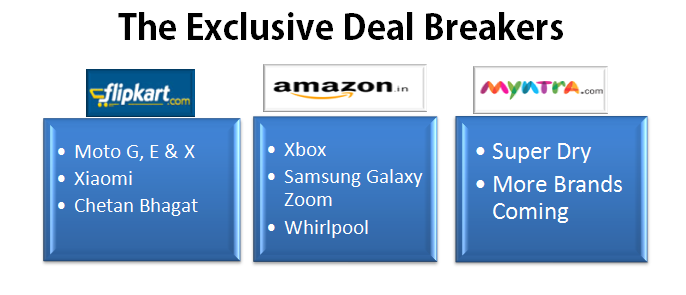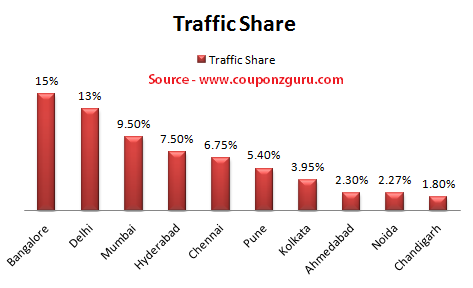Exclusivity is the flavor of the season when it comes to online retail in India. Every Indian retail player worth its name is signing exclusive tie-ups with brands to make their products available only on their portal. But how did Indian online retail, which up until now was relying heavily on ‘discounts’ to drive its growth further, suddenly changed course and jumped on to the exclusivity bandwagon?
Well, the answer to that question contains two very diverse set of reasoning. The first is the usual copying of ideas from their global counterparts, the exclusive deal strategy has worked wonderfully in the west and behemoths like Amazon swear by it. The second reason is based on conventional economics, if every player in the market ends up playing the bigger discount game, in the end no one wins. Customers just jumped from one site to the other, comparing the discounts, being loyal to none of the e-retailers and the e-retailers saw their losses increasing even further. Exclusive tie-up came as a god send boon for the e-retailers, letting them out of the never ending cycle of increasing discounts.
As usual, the homegrown leader Flipkart brought the exclusive tie-up trend to the fore by tying up with Motorola for the company’s re-entry into Indian Mobile market and what a tie-up it has been. Flipkart and in turn Motorola have sold over 1 million smartphones since Moto G’s exclusive launch on Flipkart.
The Flipkart-Motorola tie-up was the event that is solely responsible for opening the floodgates of exclusive tie-ups. When other retailers saw the potential that exclusive tie-up had, everyone started jumping in the bandwagon. Amazon signed a similar deal with Samsung for Galaxy K Zoom and with Karbonn for Titanium Hexa, in July. That’s not all, Amazon has recently signed a deal with Microsoft, becoming the exclusive retail channel for the company’s Xbox consoles.
It’s not only Mobile phone category that is seeing exclusive tie-ups. Myntra signed an exclusive deal with SuperDry for its footwear and accessories range, while Amazon has become the exclusive retailer for Whirlpool’s Kitchen Aid range.
Flipkart strengthened its exclusive tie-up portfolio by partnering with the Chinese Smartphone maker Xiaomi. Xiaomi, in its short existence of 4 years has gained significant clout in the smartphone market, especially in China, owing to the company’s clear-cut strategy right from the start. Xiaomi only sells its mobile phones online, everywhere in the world and doesn’t spend a penny on promotion, enabling the company to pass on this entire savings directly to customers. Xiaomi Mi3, which the company recently launched, has seen unprecedented sell out in the ‘flash’ sales took place on Flipkart.
Flipkart is following its exclusive tie-up story to other categories as well. The company recently announced an exclusive tie-up with Rupa Publication for the forthcoming book by the bestselling author Chetan Bhagat. Although the deal is only for online retailing as the book would be available in brick and mortar bookstores when it releases, this brings us to the next important topic in exclusive tie-ups.
The exclusive tie-ups that are happening can be broadly classified into two categories, totally exclusive and exclusive only online. While Brands like Motorola and Xiaomi have gone for totally exclusive tie-ups, meaning they won’t sell their products through any other sales channel other than Flipkart’s online store, brands which have a ground presence generally prefer exclusive only online route through which they partner with a single online retailer and this is the dilemma for exclusive tie-ups.
While totally exclusive tie-up works for online retailers as they are able to generate sales while maintaining good margins, in terms of brands it can only work for those which are entering or re-entering the Indian market. None of the brands with a ground presence can think of moving completely online as online retail doesn’t even constitute 1% of the total Indian retail market.
While figures of $1 billion in gross merchandise sale may look impressive by Indian standards, when compared to global standard they are pittance. China’s total online retail market alone is estimated to be worth around $300 billion, while India is yet to break even the $5 billion mark. The Indian online retail market is expected to grow to $32 billion 2020, but it will still constitute only 3% of the total Indian retail market.
Exclusive tie-ups are good for brands as they can count on added push by the online retailer when it comes to promotion and online retailers definitely benefit when shoppers don’t have a choice, but to buy from them. The cons though are only for the brands as they are not able to expand their reach to the majority of Indian population which still doesn’t access internet. It also remains to be seen how brick and mortar retailers react when exclusive tie-ups become a routine phenomena, whether they will come up with their own strategy or play the deal breakers?



